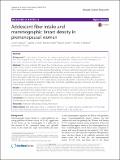| dc.contributor.author | Yaghjyan, Lusine | en_US |
| dc.contributor.author | Ghita, Gabriela L. | en_US |
| dc.contributor.author | Rosner, Bernard | en_US |
| dc.contributor.author | Farvid, Maryam | en_US |
| dc.contributor.author | Bertrand, Kimberly A. | en_US |
| dc.contributor.author | Tamimi, Rulla M. | en_US |
| dc.date.accessioned | 2016-10-11T20:28:50Z | |
| dc.date.issued | 2016 | en_US |
| dc.identifier.citation | Yaghjyan, Lusine, Gabriela L. Ghita, Bernard Rosner, Maryam Farvid, Kimberly A. Bertrand, and Rulla M. Tamimi. 2016. “Adolescent fiber intake and mammographic breast density in premenopausal women.” Breast Cancer Research : BCR 18 (1): 85. doi:10.1186/s13058-016-0747-8. http://dx.doi.org/10.1186/s13058-016-0747-8. | en |
| dc.identifier.issn | 1465-5411 | en |
| dc.identifier.uri | http://nrs.harvard.edu/urn-3:HUL.InstRepos:29002704 | |
| dc.description.abstract | Background: To date, there is limited and inconsistent epidemiologic evidence for associations of adolescent diet with mammographic breast density, a strong and consistent predictor of breast cancer. We investigated the association of adolescent fiber intake with mammographic density in premenopausal women. Methods: This study included 743 cancer-free premenopausal women (mean age, 44.9 years) within the Nurses’ Health Study II cohort. Percent breast density, absolute dense and non-dense areas were measured from digitized film mammograms using a computer-assisted thresholding technique. Adolescent and adult diet were assessed with a food frequency questionnaire; energy-adjusted nutrient intakes were estimated for each food item. Information regarding breast cancer risk factors was obtained from baseline or biennial questionnaires closest to the mammogram date. We used generalized linear regression to quantify associations between quartiles of adolescent fiber intake and each of the breast density measures, adjusted for potential confounders. Associations were examined separately for total fiber intake; fiber from fruits, vegetables, legumes, and cereal; and food sources of fiber (fruits, vegetables, and nuts). Results: In multivariable analyses, total fiber intake during adolescence was not associated with percent breast density (p for trend = 0.64), absolute dense area (p for trend = 0.80), or non-dense area (p for trend = 0.75). Similarly, neither consumption of fiber from fruits, vegetables, legumes, or cereal nor specific sources of fiber intake (fruits, vegetables, or nuts) during adolescence were associated with any of the mammographic density phenotypes. Conclusions: Our findings do not support the hypothesis that adolescent fiber intake is associated with premenopausal mammographic breast density. | en |
| dc.language.iso | en_US | en |
| dc.publisher | BioMed Central | en |
| dc.relation.isversionof | doi:10.1186/s13058-016-0747-8 | en |
| dc.relation.hasversion | http://www.ncbi.nlm.nih.gov/pmc/articles/PMC4983022/pdf/ | en |
| dash.license | LAA | en_US |
| dc.subject | Adolescent diet | en |
| dc.subject | Breast density | en |
| dc.subject | Fiber intake | en |
| dc.title | Adolescent fiber intake and mammographic breast density in premenopausal women | en |
| dc.type | Journal Article | en_US |
| dc.description.version | Version of Record | en |
| dc.relation.journal | Breast Cancer Research : BCR | en |
| dash.depositing.author | Rosner, Bernard | en_US |
| dc.date.available | 2016-10-11T20:28:50Z | |
| dc.identifier.doi | 10.1186/s13058-016-0747-8 | * |
| dash.contributor.affiliated | Farvid, Maryam | |
| dash.contributor.affiliated | Tamimi, Rulla | |
| dash.contributor.affiliated | Rosner, Bernard | |


